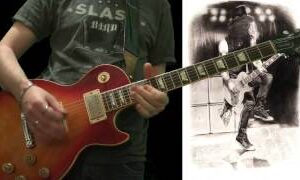When crafting heavy and powerful guitar riffs, drop D tuning is a formidable weapon in a guitarist’s arsenal. With its low, thunderous tones and increased sonic possibilities, drop D tuning has left an indelible mark on the world of metal and hard rock. This article will delve into the technical aspects of guitar playing in drop D tuning, exploring techniques, tips, and iconic examples that have shaped the genre.
-
Understanding Drop D Tuning: Drop D tuning involves lowering the pitch of the lowest string (E string) by a whole step, transforming it into a D. This simple adjustment opens up a world of sonic possibilities, allowing guitarists to tap into deeper, heavier tones. Understanding tuning and how it affects chord shapes and fingerings is crucial for mastering drop D riffs.
-
Power Chords and Chunky Rhythms: Drop D tuning lends itself perfectly to creating powerful and chunky guitar riffs. Guitarists can create intense, low-end-driven rhythms using power chords consisting of the root note and the fifth. Experimenting with palm muting, accents, and syncopation adds depth and dynamics to these riffs.
-
Incorporating Open Strings and Harmonics: The lowered sixth string in drop D tuning offers opportunities to incorporate open strings into riffs, adding richness and resonance to the sound. Additionally, utilizing natural and artificial harmonics with open strings can create mesmerizing and haunting guitar passages that cut through the mix.
-
Drop D Soloing Techniques: While drop D is often associated with heavy riffs, it can also be a fantastic solo tool. Exploring techniques such as string bending, vibrato, and tapping in the context of drop D opens up new possibilities for melodic expression. Utilizing the lower string as a pedal point can add depth and tension to your solos.
-
Iconic Drop D Riffs and Their Analysis: Drawing inspiration from iconic drop D riffs, we analyze and break down notable examples from the metal and hard rock repertoire. We explore the characteristics of these riffs, dissect the chord progressions, and provide tablature to help aspiring guitarists master them. By studying these influential riffs, you can gain insights into their construction and use them as a springboard for your creative explorations.
Conclusion: Drop D tuning has played an integral role in shaping the sonic landscape of metal and hard rock. By understanding the technical aspects of guitar playing in drop D tuning and exploring various techniques, guitarists can unlock a world of heavy, dynamic, and captivating riffs. With practice, experimentation, and a keen ear for creativity, you can harness the power of drop D to create your own signature sound that leaves a lasting impact in heavy music.



![Slayer - Angel of Death [Unholy Alliance : DVD] (HQ)](https://metalheadrock-109ad.kxcdn.com/wp-content/uploads/2025/03/mqdefault-3-150x150.jpg)







